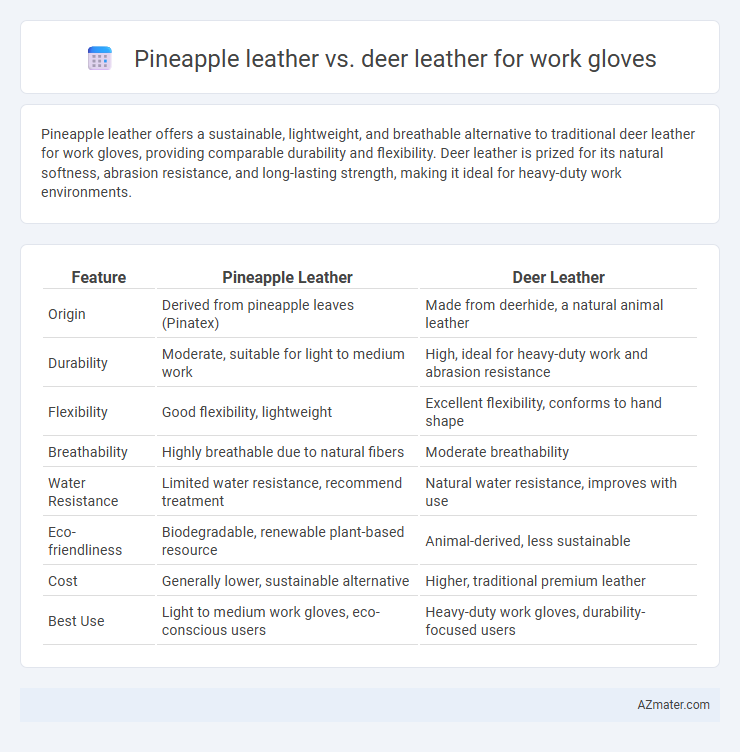Pineapple leather offers a sustainable, lightweight, and breathable alternative to traditional deer leather for work gloves, providing comparable durability and flexibility. Deer leather is prized for its natural softness, abrasion resistance, and long-lasting strength, making it ideal for heavy-duty work environments.
Table of Comparison
| Feature | Pineapple Leather | Deer Leather |
|---|---|---|
| Origin | Derived from pineapple leaves (Pinatex) | Made from deerhide, a natural animal leather |
| Durability | Moderate, suitable for light to medium work | High, ideal for heavy-duty work and abrasion resistance |
| Flexibility | Good flexibility, lightweight | Excellent flexibility, conforms to hand shape |
| Breathability | Highly breathable due to natural fibers | Moderate breathability |
| Water Resistance | Limited water resistance, recommend treatment | Natural water resistance, improves with use |
| Eco-friendliness | Biodegradable, renewable plant-based resource | Animal-derived, less sustainable |
| Cost | Generally lower, sustainable alternative | Higher, traditional premium leather |
| Best Use | Light to medium work gloves, eco-conscious users | Heavy-duty work gloves, durability-focused users |
Overview of Pineapple Leather and Deer Leather
Pineapple leather, made from the fibrous leaves of the pineapple plant, offers an eco-friendly, biodegradable alternative to traditional animal hides, featuring a lightweight texture and impressive durability ideal for breathable work gloves. Deer leather, known for its supple softness and exceptional strength, provides excellent dexterity, abrasion resistance, and natural stretch, making it a preferred choice for high-performance, rugged work gloves in demanding environments. Both materials balance sustainability and functionality, with pineapple leather excelling in vegan and environmentally conscious applications, while deer leather delivers superior comfort and resilience for heavy-duty tasks.
Sustainability Comparison
Pineapple leather, derived from pineapple leaf fibers, offers a sustainable alternative to traditional deer leather by utilizing agricultural waste and reducing animal exploitation. Deer leather involves animal farming, which contributes to higher carbon emissions, land use, and water consumption compared to plant-based pineapple leather. The biodegradable properties and lower environmental footprint of pineapple leather make it a more eco-friendly choice for work gloves aiming to minimize ecological impact.
Production Process Differences
Pineapple leather is produced by converting pineapple leaf fibers into a durable, breathable material through a mechanical and chemical process that focuses on sustainability and uses fewer harmful chemicals compared to traditional tanning. Deer leather undergoes a complex tanning process involving chemical treatments to enhance softness and durability, often requiring more water and energy resources. The pineapple leather production emphasizes eco-friendly practices and renewable resources, while deer leather production relies on animal hides and conventional tanning techniques with greater environmental impact.
Durability for Work Gloves
Pineapple leather, also known as Pinatex, offers moderate durability with excellent breathability and eco-friendly benefits but may not withstand heavy abrasion or prolonged exposure to rough conditions compared to deer leather. Deer leather is renowned for its superior durability, flexibility, and natural strength, making it highly resistant to wear and tear in rigorous work glove applications. For demanding work environments, deer leather provides longer-lasting protection and resilience, whereas pineapple leather suits lighter-duty tasks prioritizing sustainability.
Comfort and Flexibility
Pineapple leather, made from pineapple leaf fibers, offers superior breathability and lightweight comfort for work gloves, enhancing long hours of wear. Deer leather provides exceptional softness and flexibility, conforming easily to hand movements and ensuring dexterity in demanding tasks. Both materials support comfort and flexibility, with pineapple leather excelling in moisture management and deer leather in tactile sensitivity.
Water Resistance and Breathability
Pineapple leather, derived from sustainable pineapple fibers, offers excellent water resistance due to its synthetic coating that prevents liquid absorption, making it ideal for work gloves exposed to moisture. Deer leather, naturally porous and soft, provides superior breathability but tends to absorb water, which can reduce durability and comfort in wet conditions. For work gloves requiring a balance of water resistance and breathability, pineapple leather outperforms deer leather in maintaining dryness, while deer leather excels in airflow and flexibility.
Cost and Accessibility
Pineapple leather offers a cost-effective and sustainable alternative to deer leather, with prices generally 20-30% lower due to its plant-based origin and less resource-intensive production. Deer leather, while more expensive, provides superior durability and abrasion resistance, making it a preferred choice for heavy-duty work gloves. Accessibility for pineapple leather is increasing in regions with strong agricultural sectors, whereas deer leather remains more readily available through traditional leather suppliers worldwide.
Ethical and Environmental Impact
Pineapple leather, derived from agricultural waste, offers a sustainable alternative to traditional deer leather by reducing reliance on animal farming and minimizing environmental degradation. Production of pineapple leather involves fewer greenhouse gas emissions and less water consumption compared to deer leather, which is associated with deforestation, habitat loss, and ethical concerns regarding animal welfare. Opting for pineapple leather work gloves supports eco-friendly practices and cruelty-free sourcing, making it a preferred choice for environmentally conscious consumers.
Maintenance and Longevity
Pineapple leather offers exceptional durability with superior resistance to water and stains, requiring minimal maintenance such as gentle wiping and occasional conditioning, which extends its lifespan significantly. Deer leather, while softer and more breathable, demands more frequent care including regular moisturizing and avoiding prolonged exposure to moisture to prevent cracking and drying. Work gloves made from pineapple leather generally provide longer-lasting performance under harsh conditions, whereas deer leather gloves prioritize comfort but need diligent upkeep to maintain their integrity.
Best Use Cases for Each Material
Pineapple leather offers excellent breathability and eco-friendliness, making it ideal for lightweight work gloves used in gardening, light assembly, or tasks requiring dexterity and reduced sweat buildup. Deer leather provides superior softness, durability, and flexibility, best suited for heavy-duty work gloves in construction, welding, or tasks demanding enhanced protection and abrasion resistance. Choosing between pineapple and deer leather depends on the balance of sustainability, comfort, and durability required for specific job functions.

Infographic: Pineapple leather vs Deer leather for Work glove
 azmater.com
azmater.com